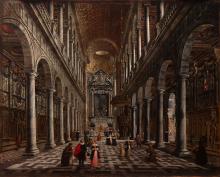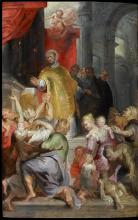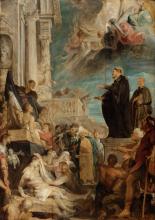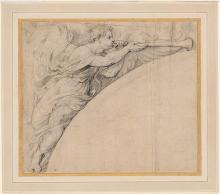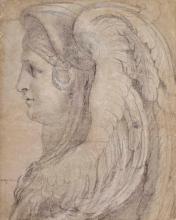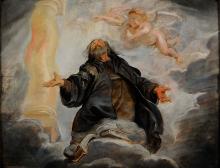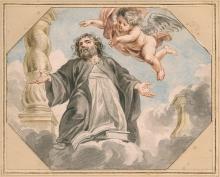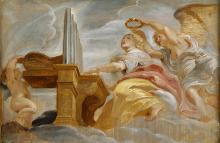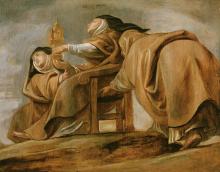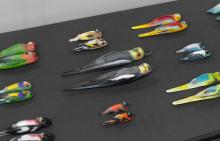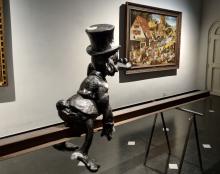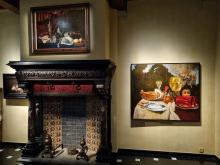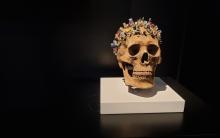Exhibition - Past
BAROQUE INFLUENCERS. JESUITS, RUBENS AND THE ART OF PERSUASION
22 April 08:00 – 16 July 17:00
A special exhibition at three historic locations forms the heart of the festival. It will allow you to experience the baroque in a surprising way.
To win over their audience, the Jesuits developed a unique visual culture that was influential as far away as China. The central exhibition shows how the leading figures of Antwerp in the long seventeenth century thought, dreamed, worked and prayed.
One such protagonist was Peter Paul Rubens. At the request of the Jesuits, he created thirty-nine ceiling paintings in St Charles Borromeo Church. These were lost in the fire of 1718. During Baroque Influencers, we will bring that lost art treasure back to life at The Snijders&Rockox House. We will do so by using more than forty domestic and foreign masterpieces by Peter Paul Rubens, Jacob de Wit and Daniel Seghers.
Furthermore, the exhibition in St Charles Borromeo Church gathers devotional prints, etchings and books from the collections of various heritage institutions, including the Ruusbroec Society. In the Nottebohm Hall of the Hendrik Conscience Heritage Library, you can admire a reconstruction of the rich interior of the Sodality and the baroque chapel it once was.
The exhibition will be held in three locations: Museum Snijders&Rockoxhuis, the galleries of St Charles Borromeo Church, and the Nottebohm Hall of the Hendrik Conscience Heritage Library*
FINIS TERRAE
November 17th 2022 - February 26th 2023
Jede Strasse führt ans End' der Welt - - Friedrich von Schiller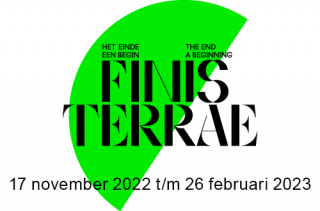
Cape Finisterre, a granite hill located in Galicia, marked the border of the Roman Empire and the western part of the earth; it was their Finis Terrae. Today, our worldview is broader, but the boundaries of our society, how it evolves and might ever end, is a question that humanity has asked itself since its inception. Whether it was the Bible or Martin Luther, Isaac Newton or the Mayas, they all had their own theory predicting the end of times.
More than ever, the limits of our world are being exposed. Global emergencies such as the climate- and energiecrisis, increasing extremism, global forest fires, the on-going refugee crisis, the pandemic, and so much more, make us reflect on the importance of our planet and the core values of our society. Furthermore, a crisis situation sets minds in motion. For example, the corona pandemic generated increased awareness of the importance of health care and a green environment, and in recent years bottom-up movements such as Youth for Climate, #MeToo, Black Lives Matter and others have joined forces to counterbalance problems that have been ignored for years.
Fifty contemporary Belgian (or residing in Belgium) artists show work that represents their vision on this theme. The exhibition tackles a wide range of topics: from statement to message, from confrontation to dialogue. There is both Sehnsucht for a Paradise Lost, and a quest for equality by a young generation of women. There is the beauty of a hidden piece of nature - a hortus conclusus - in a dense city, but also innovative scientific/artistic research within everyday reality on one side and the virtual realm of fake reality and the metaverse on the other. Furthermore, we see a struggle of the individual against ruling ideologies, or the (great) socio-cultural impact of isolation in the event of a pandemic or war. Which borders do we push - and which do we cross?
The exhibition takes place at thirteen unique and diverse locations in the city center of Antwerp, including a vacant flat, the garden of the Cathedral of Our Lady (with a unique view of its Gothic architecture), Antwerp's oldest street, a gallery, public spaces, and some impressive heritage institutions such as the Nottebohm room of the Hendrik Conscience Library, Museum Plantin-Moretus & Snijders&Rockoxhuis.
As with ECCE HOMO, this exhibition is linked to HUMAN RIGHTS WATCH. The focus will be set on the environment division, and more specifically on the humanitarian consequences of climate change.
FINIS TERRAE is Gallery Geukens & De Vil's fourth project of such scale. In 2008, the gallery organised the socially engaged exhibition UN-SCR-1324 (the only UN resolution dealing solely with the position of women in conflict zones). This exhibition eventually found its way to the Chelsea Art Museum in New York. In 2010, there was the group exhibition When will they finally see the Power of Drawing, on contemporary drawing in Belgium. Finally, in 2017-2018, the successful exhibition ECCE HOMO was organized at various locations in Antwerp, with 63 contemporary Belgian artists presenting work about man and mankind.
This project is made possible thanks to the support of Ackermans & van Haaren, Bank Van Breda and the City of Antwerp.
FINIS TERRAE - 17/11/2022 – 26/02/2023
The end. A beginning.
Five years after the successful exhibition ECCE HOMO (2017-2018), Yasmine Geukens & Marie-Paule De Vil, in collaboration with Lien Craps and Eric Rinckhout, are once again organizing a group exhibition uniting contemporary Belgian artists around one contemporary theme: FINIS TERRAE.
This exhibition runs from 17 November 2022 to 26 February 2023, and takes place at various (historical) locations throughout the city of Antwerp.
FINIS TERRAE aims to take a look at our world today. More than ever, the boundaries of our contemporary society are laid bare. In addition, a crisis situation sets minds in motion. The exhibition therefore also aims to highlight hope, the resilience of mankind, and the power of art.
No distinction is made between young and old, male and female, white and colored, nor between any artistic discipline. The curators deliberately opt for living, Belgian artists (and artists residing in Belgium).
Like ECCHE HOMO, this exhibition is linked to the organization HUMAN RIGHTS WATCH, and more specifically to the division of environment and the humanitarian consequences that climate change can bring about.
Artists in the Snijders&Rockox House:
Berlinde De Bruyckere, Thierry De Cordier, Sanam Khatibi, Maarten Vanden Eynde, Cindy Wright, Ben Sledsens , Jan Van Imschoot, Charles Degeyter, Babs Decruyenaere, Lara Gasparotto, Peter De Meyer.
Keyboard Instruments - 26/3 – 26/6/2022
Virginals, harpsichords and organs depicted in the 16th and 17th centuries
 The Snyders&Rockox House has joined forces with the Vleeshuis Museum in Antwerp to present the exhibition Keyboard Instruments as an extension to its music room.
The Snyders&Rockox House has joined forces with the Vleeshuis Museum in Antwerp to present the exhibition Keyboard Instruments as an extension to its music room.
Paintings featuring harpsichords, virginals and organs offer us a glimpse of gorgeous interiors, amorous scenes and finely-dressed ladies – and the occasional young man too – at the keyboard. Keyboard instruments can also be the key to decoding an allegory, myth or hidden message in a painting.
Other exhibits include painted harpsichord and virginal lids as well as original instruments.
Loans from the National Gallery in London, the Rijksmuseum in Amsterdam, the Suermondt-Ludwigmuseum in Aachen and many other museums and collectors offer a delight for eyes and ears.
Read More
The music room at the Snyders&Rockox House evokes the Jewish-Portuguese Duarte family, who came to Antwerp in the 16th century to flee the Inquisition. They were drawn by the commercial opportunities offered by the city, where they lived in a patrician residence on the Meir, the most important street. Besides an exceptional collection of paintings by leading Italian and above all Flemish masters, from Titian and Tintoretto to Quinten Massys, Peter Paul Rubens and Anthony Van Dyck, the family also owned five harpsichords and virginals.
Duarte did not have to look far to find them, as Antwerp was one of the leading centres for the construction of these instruments and two if not more important harpsichord builders belonged to the businessman’s circle of acquaintances.
The first references to harpsichord builders in Antwerp date from the beginning of the 16th century. It was between 1560 and 1660, however, that the city was known as the undisputed world capital of harpsichord production. Every year, Antwerp workshops turned out hundreds of harpsichords and virginals. Contemporaries praised the instruments for the richness of their sound and their reliability. The members of the Ruckers-Couchet family were especially renowned for their exceptionally high-quality instruments. Hans Ruckers, his sons Joannes and Andreas and his grandson Joannes Couchet did for instrument-making what Peter Paul Rubens was doing for painting and Christophe Plantin for printing. The Ruckers-Couchet family was not alone: names like Marten van der Biest, Joos Karest, Cornelis and Simon Hagaerts, Joris Britsen and many others also stood for excellent quality. Antwerp harpsichords and virginals did not only sell very well locally, they were sought-after throughout Europe and even far beyond until well into the eighteenth century. A substantial proportion of Antwerp’s harpsichord output, like that of its paintings and ornamental furniture, was destined for the international market.
The city also developed a strong tradition in the building of domestic and church organs. Dozens of organ builders were active in the 16th century alone, including the Moors and Brebos families. The Ruckers-Couchet family worked with organs too: Joannes Ruckers, for instance, was responsible for a while for maintaining the organ at Antwerp Cathedral.
The rise of the Antwerp keyboard builders was accompanied by a flourishing music printing industry (Antwerp was not the first or the only centre of music publication, but it was certainly one of the most important) and an emerging bourgeois culture in which music too played a part.
The original instruments are a lasting testimony to musical life in Antwerp, as are the paintings that explore them as their subject matter.
-
 Portrait of a Musical Family (Duarte Family) - Gonzales Coques
Portrait of a Musical Family (Duarte Family) - Gonzales Coques
-
 Family portrait - Frans Floris
Family portrait - Frans Floris
-
 Saint Cecilia with angels - Hendrick Goltzius
Saint Cecilia with angels - Hendrick Goltzius
-
 Harpsichord - Joris Britsen III
Harpsichord - Joris Britsen III
-
 A Young Woman playing a Harpsichord to a Young Man - Jan Steen
A Young Woman playing a Harpsichord to a Young Man - Jan Steen
-
 Ottavino (child virginal) - Andreas Ruckers I
Ottavino (child virginal) - Andreas Ruckers I
-
 Still life with harpsichord - Pieter van Roestraeten
Still life with harpsichord - Pieter van Roestraeten
-
 Virginal - Cornelis Hagaerts
Virginal - Cornelis Hagaerts
-
 Woman at the virginal - Gabriel Metsu
Woman at the virginal - Gabriel Metsu
-
 Woman Playing the Virginal - Jan Miense Molenaer
Woman Playing the Virginal - Jan Miense Molenaer
‘P.LACE.S - Looking through Antwerp Lace’.
25/09/2021 - 09/01/2022.
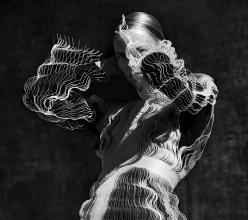 The exhibition ‘P.LACE.S - Looking through Antwerp Lace’ highlights the important role the city played in the production and trade of lace.
The exhibition ‘P.LACE.S - Looking through Antwerp Lace’ highlights the important role the city played in the production and trade of lace.
MoMu tells this story through an exhibition trail that connects five locations in the city.
With ‘P.LACE.S’, MoMu is starting a unique conversation between historical textile craft and contemporary fashion to look at our history from a different perspective.
This creates a visual play between past and present, presenting objects from international collections that have never been shown in Belgium before.
In the Snijders&Rockox House, the exhibition shows exceptional lace and contemporary fashion in historic interiors.
Credits : Iris van Herpen S/S 2017 in collaboration with Philip Beesley, Model: Elza Matiz, Photo: Sølve Sundsbø / Art + Commerce





